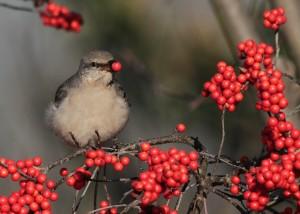Many birds fly south to spend the winter in warmer places where they can find food more easily. But North Carolina is home to many birds that stay year-round. What do they eat in late fall and winter? Many of the plants on the 2015 Bird-Friendly Native Plants of the Year list help our bird friends find enough to eat on cold days when the insects they feasted on all summer are scarce.
Yes, we are giving you a reason not to deadhead your flowers this fall. Just tell everyone it’s for the birds!
BERRIES: Mockingbirds, bluebirds, waxwings, woodpeckers, and the little-known but downright friendly Hermit Thrush will appreciate these berries this winter:
- Winterberry (Ilex verticillata) – This native holly loses its leaves, but that just shows off the incredibly plentiful bright red-orange berries, which last at least until New Year’s.
- Eastern Red Cedar (Juniperus virginiana) – Dusty-blue berries last through February AND cedars provide excellent winter shelter for birds.

SEEDS: American Goldfinches, House Finches, and sparrows will appreciate these plants that provide seeds for them to munch on until Thanksgiving or later:
- Eastern Aromatic Aster (Symphotrichum oblongifolium) – The bounty of purple flowers gives way to a bounty of seeds.
- Purple Coneflower (Echinacea purpurea) – Pink, purple, orange or red – depending on the cultivar – flowers lead to seeds that just might be the favorite food of the American Goldfinch. But, don’t quote us on that.
- Switchgrass (Panicum virgatum) – One of our showier native grasses, guaranteed to add architectural interest to your garden.
NUTS: Many native oaks provide important food for blue jays, woodpeckers and Wild Turkeys through the fall, winter and spring. Blue jays are obsessed with harvesting and storing acorns right now, and they are capable of carrying five acorns at once! Wild Turkeys can gobble 200 acorns in one meal.
- Overcup Oak (Quercus lyrata) – These are best to plant in the Coastal Plain and Piedmont regions
- Red Oak (Quercus rubra) – These are best to plant in the Piedmont and Mountains





